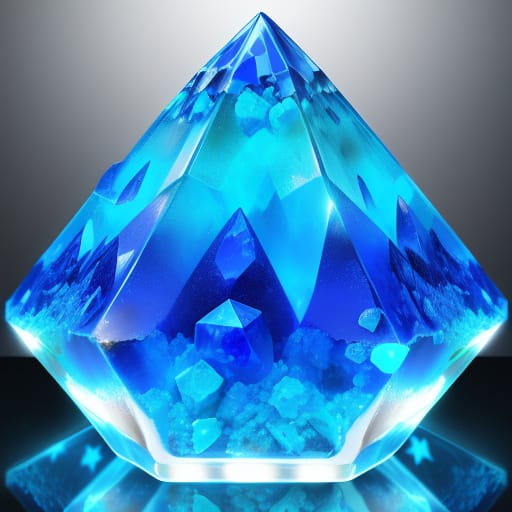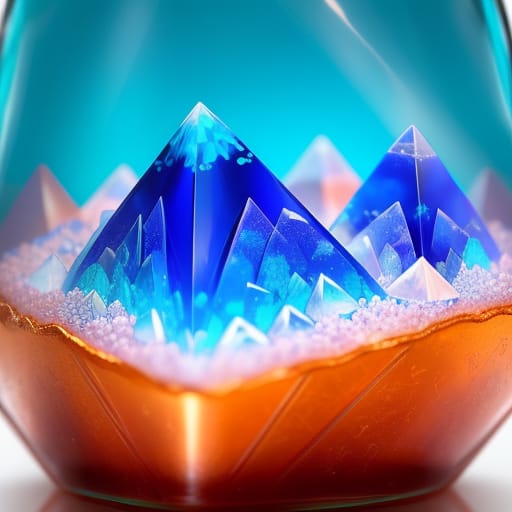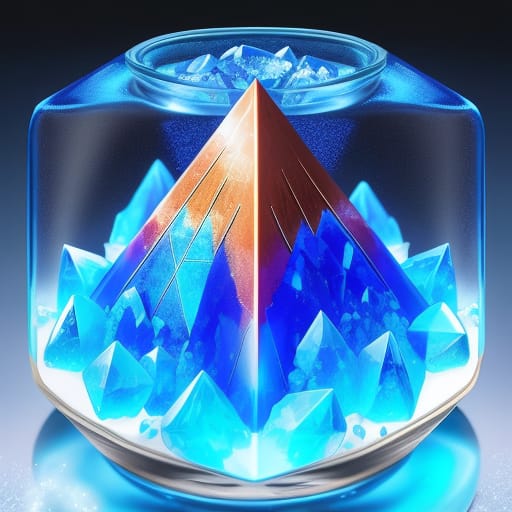Have you ever looked closely at a crystal and marveled at its unique geometric shape and beauty? Crystals form naturally over thousands or even millions of years, but you can grow your own crystals at home in a matter of days!
Growing crystals is a fun science experiment that allows you to observe these stunning formations up close. Plus, it’s easy to do with common household materials.
In this beginner’s guide, you’ll learn:
- What crystals are and how they form
- The best materials for crystal growing experiments
- Step-by-step instructions for growing various types of crystals
- Tips for maximizing crystal size and purity
So let’s get started with the magical world of crystal growing!

What Are Crystals and How Do They Form?
Crystals are solid materials in which the molecules are arranged in an orderly, repeating 3D pattern. The word “crystal” comes from the Greek word “krystallos”, meaning clear ice.
Some common examples of crystals include:
- Diamond
- Quartz
- Salt
- Snowflakes
- Sugar
Crystals can form from molten lava, mineral-rich water solutions, and even frozen liquids like ice. In order for a crystal to grow, the solution needs to be supersaturated. This means it contains more dissolved molecules than can normally remain dissolved at a given temperature.
As the solution cools or evaporates, the excess dissolved molecules are forced out of the solution and begin attaching themselves to the crystal’s surface in an ordered symmetrical way. This addition of molecules results in crystal growth.
The key factors that affect crystal growth are:
- Temperature – Warmer temperatures allow more molecules to remain dissolved. Cooler temperatures cause molecules to precipitate out.
- Concentration – Solutions with higher concentrations of dissolved material will yield larger crystals.
- Pressure – Changes in pressure alter solubility. Lower pressure encourages crystal growth.
- pH – Acidic or basic conditions affect crystal formation for some compounds.
- Seed crystal – A small crystal added to the solution provides a foundation for further growth.
Now let’s look at some of the best materials for growing stunning crystals at home!
Best Materials for Growing Crystals
Many household chemicals and food items can be used for DIY crystal growing. Here are some of the best options:
Sugar Crystals
Sugar (sucrose) is one of the easiest substances to crystallize. As sugar solution evaporates, the excess sugar recrystallizes in characteristic cube shapes.
You will need:
- Granulated sugar
- Hot water
- Glass jar
- Pencil or stick
- String
- Saucepan
Recipe:
- Heat 1 cup of water in a saucepan until boiling.
- Slowly stir in sugar (about 2.5 cups) until it no longer dissolves. This creates a supersaturated solution.
- Pour the solution into a jar and let cool slightly.
- Tie a string around a pencil and suspend it in the jar so the string hangs in the solution.
- Place jar in warm spot and wait 1-2 weeks for crystals to grow on string.
Tips:
- Filter solution through coffee filter to remove impurities.
- Try different sugars like rock sugar or brown sugar.
- Suspend objects like sticks or popsicle sticks in the jar for crystallization.
Table Salt Crystals
Table salt (NaCl) also readily forms crystals. The key is allowing the salt water to evaporate slowly to produce well-defined cubes.
You will need:
- Table salt
- Water
- Glass jar
- Saucepan
- Pipe cleaners or string (optional)
Recipe:
- Heat 1 cup water, then stir in salt a tablespoon at a time until no more dissolves (about 3 tbsp).
- Pour the solution into the jar. For crystals on a string, bend the pipe cleaner into shape and suspend it in a jar.
- Cover the jar with plastic wrap poked with small holes. Allow to slowly evaporate.
- Crystals will grow in 1-2 weeks. Larger crystals will form on a string or object.
Tips:
- Use warm or hot water to dissolve more salt.
- Add a drop of food coloring for colored crystals.
- Try different shapes like pipe cleaners or sticks.
Epsom Salt Crystals
Epsom salt (magnesium sulfate) crystallizes similar to table salt forming clusters of small clear crystals.
You will need:
- Epsom salt
- Water
- Glass jar
- Saucepan
Recipe:
- Heat 1 cup water, add 1/2 cup Epsom salt, stir until dissolved.
- Allow the solution to cool slightly, then pour into a jar.
- Refrigerate overnight to encourage crystallization.
- Crystals will form within 1-2 days.
Tips:
- Try adding food coloring to the solution.
- For single crystals, use a seed crystal.
- Increase solution concentration for larger crystals.
Alum Crystals
Alum powder is potassium aluminum sulfate and can be found in the spice section. It crystallizes into beautiful translucent octahedrons and other shapes.
You will need:
- Alum powder
- Water
- Glass jar
- Pot
Recipe:
- Fill jar halfway with hot water. Slowly stir in alum powder until no more dissolves.
- Cover jar with lid and place in refrigerator overnight to crystallize.
- Pour off any remaining liquid, leaving only the crystals.
- To recrystallize, add hot water to dissolve crystals, then cool to recrystallize.
Tips:
- Suspend a small crystal in solution to act as a seed crystal.
- Use purified or distilled water for clarity.
- Try adding food coloring.
Borax Crystals
Borax (sodium tetraborate) is a household cleaner that grows into lovely geometric crystals.
You will need:
- Borax powder
- Water
- Glass jar
- Pipe cleaners
Recipe:
- Dissolve 1 tbsp borax in 1 cup hot water, stir until fully dissolved.
- Wet pipe cleaner and shape into design. Suspend in jar.
- Allow jar to sit undisturbed for 2 weeks. Crystals will form on pipe cleaner.
- Remove pipe cleaner carefully once fully encrusted in crystals.
Tips:
- Use a seed crystal for a central starting point.
- Try dipping pipe cleaner in food coloring before inserting.
- Vary the borax to water ratio to change crystal size.
Copper Sulfate Crystals
Copper sulfate forms electric blue crystals, also shaped like pyramids or octahedrons.
You will need:
- Copper sulfate powder
- Distilled water
- Glass jar
Recipe:
- Stir 2 tbsp copper sulfate into 1 cup hot distilled water until fully dissolved.
- Allow the solution to cool slightly, then pour into a jar.
- Place an object or seed crystal in solution for crystals to grow on.
- Cover the jar and set it aside in a cool place. Crystals will form within 1 week.
Tips:
- Use purified or distilled water for clarity.
- Increase copper sulfate ratio for darker color.
- Suspend objects like sticks or stones in solution to grow on.
Potassium Bitartrate Crystals
Potassium bitartrate forms as a byproduct of winemaking. The cool crystal cubes have a diamond-like appearance.
You will need:
- Wine or grape juice
- Glass jar
Recipe:
- Pour a glass of wine or grape juice and allow it to sit uncovered for 2-3 days.
- Crystals will begin to form on the sides and bottom of the glass.
- Gently pour out extra liquid to harvest crystals once they reach the desired size.
Tips:
- Larger crystals will form on bottom of glass – allow them to grow undisturbed.
- Suspend a small crystal in fresh wine to grow larger crystals.
- Use real wine instead of juice for best crystal formation.
Techniques for Growing Crystals
There are a few basic methods you can use to grow crystals at home:
Evaporation
This is the most common technique. A supersaturated solution is allowed to slowly evaporate, leaving behind crystals as the excess solute comes out of solution. Works best for salts and sugar.
Cooling
A hot saturated solution is allowed to cool slowly, encouraging crystals to form as solubility decreases with temperature. Works well for alum, Epsom salts, borax.
Recrystallization
Dissolve crystals in hot solvent to fully saturate, then allow to cool slowly to form larger, purer crystals. Useful for purifying crystals.
Chemical Reaction
Some compounds crystallize when chemical reactions take place, like copper sulfate formed by reacting copper metal with sulfuric acid.
The evaporation method tends to produce the largest, highest quality crystals, though all techniques can yield excellent results with practice!

Growing Crystals: Simple Experiments
Growing impressive crystals requires patience, but you can perform fun experiments to observe the process on a smaller scale. Here are a few ideas:
Grow Crystals on Ice Cubes
- Freeze water with a popsicle stick or piece of yarn suspended in the ice cube tray.
- Remove once frozen and melt slightly in warm water bath. Don’t fully melt.
- Roll ice cube in Epsom salt or borax to coat.
- Place back in freezer overnight. Crystals will form on object as water re-freezes.
Crystallization in Eggshells
- Carefully rinse out raw egg and allow to dry fully.
- Fill eggshell halfway with hot alum or salt solution.
- Allow to cool slowly and crystals will form along the eggshell.
Crystal Water Garden
- Fill clear plastic cup halfway with water.
- Add a spoonful of borax and swirl to dissolve.
- Arrange plastic flowers or sticks in the cup.
- Allow to fully evaporate in a sunny window over 1 week. Crystals will form like a water garden!
Factors that Affect Crystal Shape and Size
What determines a crystal’s shape and size? Here are the key factors:
Molecular Structure
- The crystal’s molecular structure predisposes it to forming certain geometric shapes based on how the molecules align and stack together as the crystal grows.
- Common shapes like cubes, octahedrons, pyramids, rhombohedrons occur based on the natural molecular structure.
Temperature
- Warmer temperatures allow more material to remain dissolved in the solution, yielding larger crystals upon cooling.
Concentration/Solubility
- Saturated solutions with higher solute concentrations will produce larger crystals.
- Solubility varies for different substances – some require more solute to reach saturation.
Purity
- Impurities in the solution interfere with crystallization and create defects.
- Suspended particles can get trapped within crystals as they form, making them cloudy.
- Distilled water and purified chemicals result in the clearest, best formed crystals.
Patience and keeping conditions steady are key to growing picture-perfect crystals!
Purifying Crystals
While beautiful crystals can form with household materials, you can further purify crystals using these techniques:
Recrystallization
- Dissolve crystals in minimum hot solvent.
- Filter dissolved solution through coffee filter or paper towel.
- Allow filtered solution to cool slowly to reform crystals, free of impurities.
Chemical Polishing
- Soak completed crystals briefly in solvent heated close to boiling point.
- Dissolves outer imperfections while retaining crystal lattice.
Seed Crystals
- Suspend a small, perfect “seed crystal” in the solution.
- Crystals will grow outward from the seed in an ordered, symmetrical way.
Zone Refining
- In this advanced method, a crystal passes through a heated zone that causes impurities to gather at one end of the crystal.
Spectroscopy
- Powerful analytical technique that identifies contaminants by their interaction with different wavelengths of light.
A bit of effort purifying your crystals yields incredibly clear, flawless results worth showing off!
Fun Uses for Homegrown Crystals
Once you’ve harvested your homegrown crystals, there are plenty of creative ways to put them on display:
Science Fair Projects
Show off your crystals and the chemistry behind their formation. Document each step and take plenty of photos as your crystals grow.
Home Décor
Arrange crystals in geometric patterns on shelves, tables, or windowsills where light makes them sparkle. Group crystals of the same type or combine different colors and shapes.
Jewelry
Wire wrap larger crystals and incorporate them into necklaces, earrings, or bracelets. Make pendants by gluing small crystals onto chains or leather cord.
Give as Gifts
Share your crystal growing hobby with friends! Jar up batches of pre-made supersaturated solution with instructions so they can grow their own.
Bath Salts
Crush up any edible crystal types like Epsom salt or alum and add to a warm bath for relaxation.
However you put them to use, homegrown crystals make economical yet stunning additions to your space.

Key Takeaways: Growing Crystals 101
- Crystallization occurs when molecules align in a repeating orderly pattern as a solution cools and concentrates.
- The best materials for beginners are household salts, sugar, borax, and alum.
- Evaporation, cooling, and recrystallization are simple methods to produce crystals.
- Crystals form characteristic shapes based on their molecular structure.
- Controlling temperature, purity, and concentration helps maximize crystal size and appearance.
- Purification via recrystallization or chemical polishing improves crystal quality.
- Science projects, art, jewelry, and gifts are fun ways to use your homemade crystals.
With the right materials and a bit of patience, you can create gorgeous crystals rivaling natural formations. Growing crystals is an absorbing hobby that lets you
Key Takeaways: Growing Crystals 101
- Crystallization occurs when molecules align in a repeating orderly pattern as a solution cools and concentrates.
- The best materials for beginners are household salts, sugar, borax, and alum.
- Evaporation, cooling, and recrystallization are simple methods to produce crystals.
- Crystals form characteristic shapes based on their molecular structure.
- Controlling temperature, purity, and concentration helps maximize crystal size and appearance.
- Purification via recrystallization or chemical polishing improves crystal quality.
- Science projects, art, jewelry, and gifts are fun ways to use your homemade crystals.
With the right materials and a bit of patience, you can create gorgeous crystals rivaling natural formations. Growing crystals is an absorbing hobby that lets you observe these unique, symmetrical structures up close.
Frequently Asked Questions
What is the best temperature for growing crystals?
The ideal temperature is warm enough to fully dissolve the chosen material, followed by slow cooling to room temperature or below. For most crystals, a temperature between 60-70°F works well.
How long does it take for crystals to form?
Crystal formation time varies greatly. Small crystals may grow overnight while larger crystals can take 1-3 weeks, depending on the material, temperature, and saturation. Be patient, allow the solution to evaporate slowly without disturbance.
What should I use as a seed crystal?
A tiny crystal of the same type provides an orderly starting point for crystal growth. Tie floss around your chosen seed crystal and suspend it in the super saturated solution as it cools.
Why are my crystals small and grainy?
Small or irregular crystals can result from impurities or too much evaporation. Filter solutions through coffee filters and cover containers to slow evaporation. Vary the starting material concentration and temperature.
Can I grow crystals without equipment?
Yes! All you need is a jar, drinking glass, or cup. String or household items like sticks and pipe cleaners allow shapes to form. Plastic wrap with holes poked in it makes a good cover. Get creative with materials you already have on hand!